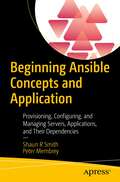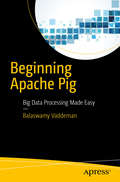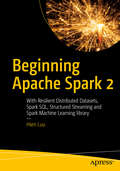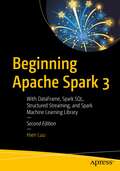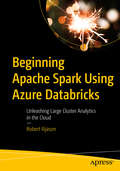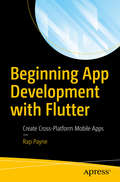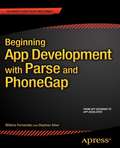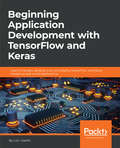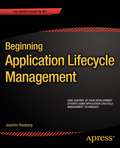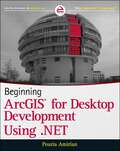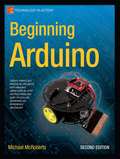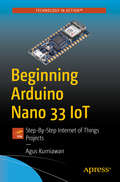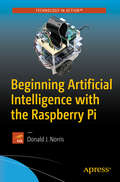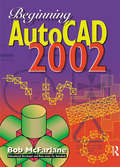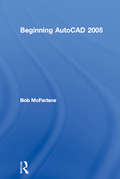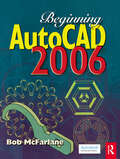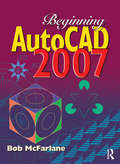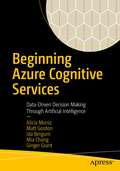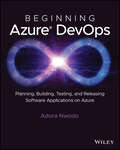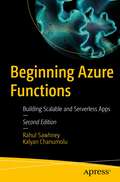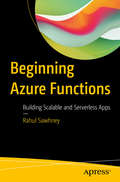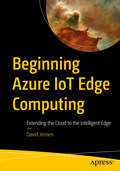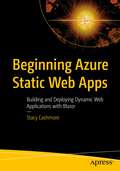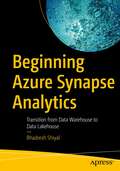- Table View
- List View
Beginning Ansible Concepts and Application: Provisioning, Configuring, and Managing Servers, Applications, and Their Dependencies
by Peter Membrey Shaun R SmithLearn the concepts and develop the skills to be a true Ansible artist and use it inside and outside the box. This book applies key concepts immediately while building up your Ansible skills layer by layer through easy to grasp examples and engaging projects. You’ll also think about security, why testing is important, and how to use version control safely.As a beginner to Ansible, you'll be guided step-by-step through creating your first Ansible playbook to deploying your first server and writing more complex cross-dependency playbooks. From the first line of code to the last, you'll constantly iterate and simplify your playbooks, iwhile taking on more complex topics as you construct a full Wordpress website stack consisting of a database, web servers, and load balancer. This book will prompt you to think about how these fit together and will explain what to do to ensure maintainability long into the future. Don’t just use Ansible. Completely change how you go about provisioning, configuring, and managing servers, applications, and their dependencies with this powerful, open source automation tool. In exchange for this power and efficiency, Ansible demands a very different way of thinking about resources and how they all fit together. This can be hard to get your head around if you’ve never done it before. Every step of the way, Beginning Ansible Concepts and Application show you best practices so that you can confidently start using Ansible right away.What You'll LearnSet up an Ansible environmentCreate and run playbooksOrganize groups of variables, vaults, roles, and tasks to ensure your playbooks are scalableProtect secrets using Ansible VaultsAutomate the build of a Wordpress websiteWho This Book Is For Developers looking for a better way to manage their servers other than by logging in and typing commands. Also enthusiasts who want to learn not just how to use Ansible but how to use it correctly and confidently.
Beginning Apache Cassandra Development
by Vivek MishraBeginning Apache Cassandra Development introduces you to one of the most robust and best-performing NoSQL database platforms on the planet. Apache Cassandra is a document database following the JSON document model. It is specifically designed to manage large amounts of data across many commodity servers without there being any single point of failure. This design approach makes Apache Cassandra a robust and easy-to-implement platform when high availability is needed. Apache Cassandra can be used by developers in Java, PHP, Python, and JavaScript--the primary and most commonly used languages. In Beginning Apache Cassandra Development, author and Cassandra expert Vivek Mishra takes you through using Apache Cassandra from each of these primary languages. Mishra also covers the Cassandra Query Language (CQL), the Apache Cassandra analog to SQL. You'll learn to develop applications sourcing data from Cassandra, query that data, and deliver it at speed to your application's users. Cassandra is one of the leading NoSQL databases, meaning you get unparalleled throughput and performance without the sort of processing overhead that comes with traditional proprietary databases. Beginning Apache Cassandra Development will therefore help you create applications that generate search results quickly, stand up to high levels of demand, scale as your user base grows, ensure operational simplicity, and--not least--provide delightful user experiences.
Beginning Apache Pig: Big Data Processing Made Easy
by Balaswamy VaddemanLearn to use Apache Pig to develop lightweight big data applications easily and quickly. This book shows you many optimization techniques and covers every context where Pig is used in big data analytics. Beginning Apache Pig shows you how Pig is easy to learn and requires relatively little time to develop big data applications. The book is divided into four parts: the complete features of Apache Pig; integration with other tools; how to solve complex business problems; and optimization of tools. You'll discover topics such as MapReduce and why it cannot meet every business need; the features of Pig Latin such as data types for each load, store, joins, groups, and ordering; how Pig workflows can be created; submitting Pig jobs using Hue; and working with Oozie. You'll also see how to extend the framework by writing UDFs and custom load, store, and filter functions. Finally you'll cover different optimization techniques such as gathering statistics about a Pig script, joining strategies, parallelism, and the role of data formats in good performance. What You Will Learn * Use all the features of Apache Pig * Integrate Apache Pig with other tools * Extend Apache Pig * Optimize Pig Latin code * Solve different use cases for Pig Latin Who This Book Is For All levels of IT professionals: architects, big data enthusiasts, engineers, developers, and big data administrators
Beginning Apache Spark 2
by Hien LuuDevelop applications for the big data landscape with Spark and Hadoop. This book also explains the role of Spark in developing scalable machine learning and analytics applications with Cloud technologies. Beginning Apache Spark 2 gives you an introduction to Apache Spark and shows you how to work with it.Along the way, you’ll discover resilient distributed datasets (RDDs); use Spark SQL for structured data; and learn stream processing and build real-time applications with Spark Structured Streaming. Furthermore, you’ll learn the fundamentals of Spark ML for machine learning and much more. After you read this book, you will have the fundamentals to become proficient in using Apache Spark and know when and how to apply it to your big data applications. What You Will Learn Understand Spark unified data processing platformHow to run Spark in Spark Shell or Databricks Use and manipulate RDDs Deal with structured data using Spark SQL through its operations and advanced functionsBuild real-time applications using Spark Structured StreamingDevelop intelligent applications with the Spark Machine Learning libraryWho This Book Is ForProgrammers and developers active in big data, Hadoop, and Java but who are new to the Apache Spark platform.
Beginning Apache Spark 3: With DataFrame, Spark SQL, Structured Streaming, and Spark Machine Learning Library
by Hien LuuTake a journey toward discovering, learning, and using Apache Spark 3.0. In this book, you will gain expertise on the powerful and efficient distributed data processing engine inside of Apache Spark; its user-friendly, comprehensive, and flexible programming model for processing data in batch and streaming; and the scalable machine learning algorithms and practical utilities to build machine learning applications. Beginning Apache Spark 3 begins by explaining different ways of interacting with Apache Spark, such as Spark Concepts and Architecture, and Spark Unified Stack. Next, it offers an overview of Spark SQL before moving on to its advanced features. It covers tips and techniques for dealing with performance issues, followed by an overview of the structured streaming processing engine. It concludes with a demonstration of how to develop machine learning applications using Spark MLlib and how to manage the machine learning development lifecycle. This book is packed with practical examples and code snippets to help you master concepts and features immediately after they are covered in each section. After reading this book, you will have the knowledge required to build your own big data pipelines, applications, and machine learning applications.What You Will LearnMaster the Spark unified data analytics engine and its various componentsWork in tandem to provide a scalable, fault tolerant and performant data processing engineLeverage the user-friendly and flexible programming model to perform simple to complex data analytics using dataframe and Spark SQLDevelop machine learning applications using Spark MLlibManage the machine learning development lifecycle using MLflowWho This Book Is ForData scientists, data engineers and software developers.
Beginning Apache Spark Using Azure Databricks: Unleashing Large Cluster Analytics in the Cloud
by Robert IlijasonAnalyze vast amounts of data in record time using Apache Spark with Databricks in the Cloud. Learn the fundamentals, and more, of running analytics on large clusters in Azure and AWS, using Apache Spark with Databricks on top. Discover how to squeeze the most value out of your data at a mere fraction of what classical analytics solutions cost, while at the same time getting the results you need, incrementally faster. This book explains how the confluence of these pivotal technologies gives you enormous power, and cheaply, when it comes to huge datasets. You will begin by learning how cloud infrastructure makes it possible to scale your code to large amounts of processing units, without having to pay for the machinery in advance. From there you will learn how Apache Spark, an open source framework, can enable all those CPUs for data analytics use. Finally, you will see how services such as Databricks provide the power of Apache Spark, without you having to know anything about configuring hardware or software. By removing the need for expensive experts and hardware, your resources can instead be allocated to actually finding business value in the data. This book guides you through some advanced topics such as analytics in the cloud, data lakes, data ingestion, architecture, machine learning, and tools, including Apache Spark, Apache Hadoop, Apache Hive, Python, and SQL. Valuable exercises help reinforce what you have learned. What You Will Learn Discover the value of big data analytics that leverage the power of the cloudGet started with Databricks using SQL and Python in either Microsoft Azure or AWSUnderstand the underlying technology, and how the cloud and Apache Spark fit into the bigger picture See how these tools are used in the real world Run basic analytics, including machine learning, on billions of rows at a fraction of a cost or free Who This Book Is ForData engineers, data scientists, and cloud architects who want or need to run advanced analytics in the cloud. It is assumed that the reader has data experience, but perhaps minimal exposure to Apache Spark and Azure Databricks. The book is also recommended for people who want to get started in the analytics field, as it provides a strong foundation.
Beginning App Development with Flutter: Create Cross-Platform Mobile Apps
by Rap PayneCreate iOS and Android apps with Flutter using just one codebase. App development on multiple platforms has historically been difficult and complex. This book breaks down complex concepts and tasks into easily digestible segments with examples, pictures, and hands-on labs with starters and solutions. In doing so, you'll develop a basic understanding of the Dart programming language; the entire Flutter development toolchain; the differences between stateful and stateless widgets; and a working knowledge of the architecture of apps. All the most important parts of app development with Flutter are covered in this book. Work with themes and styles. Develop custom widgets. Teach your app to respond to gestures like taps, swipes, and pinches. Design, create and control the layout of your app. Create tools to handle form data entry from users. And ultimately create killer multiscreen apps with navigation, menus, and tabs.Flutter is Google's new framework for creating mobile apps that run on iOS and Android phones both.You had to be a super-developer to write apps for iOS or Android alone. But writing for both? Forget about it! You had to be familiar with Swift, Java/Kotlin, Xcode, Eclipse, and a bunch of other technologies simultaneously. Beginning App Development with Flutter simplifies the entire process.What You'll Learn Get the most out of great Flutter widgets Create custom widgets, both stateless and statefulExercise expert control over your Flutter layoutsMake your app respond to gestures like swiping, pinching and tappingInitiate async Ajax calls to RESTful APIs — including Google Firebase!Who This Book Is ForDevelopers who have coded in Java, C#, C++, or any similar language. It brings app development within the reach of younger developers, so STEM groups are likely to pick up the technology. Managers, product owners, and business analysts need to understand Flutter's capabilities.
Beginning App Development with Parse and Phonegap
by Wilkins Fernandez Stephan AlberBeginning App Development with Parse and PhoneGap teaches you how to start app development with Parse and PhoneGap: free and open source software. Using the building block languages of the web--HTML, JavaScript, and CSS--you'll be on your way to creating a fully working product with minimal effort as fast as possible. With over 25 years' of combined experience, the authors make daunting tasks seem trivial. There is no book on the market that can take you from designer to developer faster. Using Facebook's Parse as backend service, and Adobe's PhoneGap (or Cordova) as a mobile development framework, building a highly customizable application is easier than you can imagine. A basic understanding of JavaScript, HTML, and CSS is not required, but it will help you pick up concepts faster. This book is geared toward a designer who wants to explore the world of application development. If you do not know anything about design, that's OK! We will walk you through step by step on how to build your first native iOS or Android app in the fastest and easiest way possible. Using free and open source software, this book will get you up and running quickly and efficiently--start using Parse and PhoneGap today with this key title. What you'll learn â-- How to get your environment set up for application development â-- Create an online Data Storage using Parse â-- Essential basics of Querying a Database: Create, Remove, Update and Delete Data â-- Use advanced native phone features like geolocation and camera access â-- How to organize your code for maximum efficiency â-- Release your application to the world online Who this book is for Beginning App Development with Parse and PhoneGap is intended for a designer or novice developer that wants to take their skills to the next level. You do not need deep knowledge of HTML, CSS, or JavaScript, but you'll be working with all of them. Using free and open source software - Parse and PhoneGap - you'll be able to get started straight away. Table of Contents 1. Introduction 2. Beginning PhoneGap 3. Beginning Parse 4. Tools and Helpers 5. Facebook API 6. The Messenger Application 7. User Registration with Parse 8. Messages 9. Location Services 10. Map Views 11. Accessing and Sharing Photos 12. Network Connection Status
Beginning Application Development with TensorFlow and Keras: Learn to design, develop, train, and deploy TensorFlow and Keras models as real-world applications
by Luis CapeloLearn to design, develop, train, and deploy TensorFlow and Keras models as real-world applicationsKey Features- Focus on neural network and its essential operations- Prepare data for a deep learning model and deploy it as an interactive web application, with Flask and a HTTP API- Use Keras, a TensorFlow abstraction library Book DescriptionWith this book, you’ll learn how to train, evaluate and deploy Tensorflow and Keras models as real-world web applications. After a hands-on introduction, you’ll use a sample model to explore the details of deep learning, selecting the right layers that can solve a given problem. By the end of the course, you’ll build a Bitcoin application that predicts the future price, based on historic, and freely available information.This book will also provide you with a blueprint for how to build an application that generates predictions using a deep learning model. From there, you can continue to improve our example model— either by adding more data, computing more features, or changing its architecture—continuously increasing its prediction accuracy, or create a completely new model, changing the core components of the application as you see fit. What you will learn- Set up a deep learning programming environment - Explore the common components of a neural network and its essential operations- Prepare data for a deep learning model- Deploy model as an interactive web application, with Flask and a HTTP API- Use Keras, a TensorFlow abstraction library - Explore the types of problems addressed by neural networksWho this book is forThis course is ideal for experienced developers, analysts, or a data scientists, who want to develop applications using TensorFlow and Keras. This rapid hands-on course quickly shows you how to get to grips with TensorFlow in the context of real-world application development. We assume that you are familiar with Python and have a basic knowledge of web application development. If you have a background in linear algebra, probability, and statistics, you will easily grasp concepts that are discussed in the course.
Beginning Application Lifecycle Management
by Joachim RossbergBeginning Application Lifecycle Management is a guide to an area of rapidly growing interest within the development community: managing the entire cycle of building software. ALM is an area that spans everything from requirements specifications to retirement of an IT-system or application. Because its techniques allow you to deal with the process of developing applications across many areas of responsibility and across many different disciplines, the benefits and effects of ALM techniques used on your project can be wide-ranging and pronounced. In this book, author Joachim Rossberg will show you what ALM is and why it matters. He will also show you how you can assess your current situation and how you can use this assessment to create the road ahead for improving or implementing your own ALM process across all of your team's development efforts. Beginning Application Lifecycle Management can be implemented on any platform. This book will use Microsoft Team Foundation Server as a foundation in many examples, but the key elements are platform independent and you'll find the book written in a platform agnostic way. In this book, you'll learn: What application lifecycle management is and why it matters. The steps necessary for implementing an ALM process. Tips and techniques you can use to gain control of your development efforts. How to implement an agile framework into your ALM processHow to achieve traceability and visibility in your projectsHow to automate your ALM process
Beginning ArcGIS for Desktop Development using .NET
by Pouria AmirianGet the very most out of the ArcGIS for Desktop products through ArcObjects and .NETArcGIS for Desktop is a powerful suite of software tools for creating and using maps, compiling, analyzing and sharing geographic information, using maps and geographic information in applications, and managing geographic databases. But getting the hang of ArcGIS for Desktop can be a bit tricky, even for experienced programmers. Core components of ArcGIS platform is called ArcObjects. This book first introduce you the whole ArcGIS platform and the opportunities for development using various programming languages. Then it focuses on ArcGIS for Desktop applications and makes you familiar with ArcObjects from .NET point of view. Whether you are an ArcGIS user with no background in programming or a programmer without experience with the ArcGIS platform, this book arms you with everything you need to get going with ArcGIS for Desktop development using .NET?right away. Written by a leading expert in geospatial information system design and development, it provides concise, step-by-step guidance, illustrated with best-practices examples, along with plenty of ready-to-use source code. In no time you?ll progress from .NET programming basics to understanding the full suite of ArcGIS tools and artefacts to customising and building your own commands, tools and extensions?all the way through application deployment. Among other things, you?ll learn to:Object-Oriented and Interface-based programming in .NET (C# and VB.NET) Finding relationship between classes and interfaces using object model diagramsQuerying dataVisualizing geographical data using various renderingCreating various kinds of Desktop Add-Ins Performing foreground and background geoprocessingLearn how to improve your productivity with ArcGIS for Desktop and Beginning ArcGIS for Desktop Development Using .NET
Beginning Arduino
by Michael McrobertsWant to light up a display? Control a touch screen? Program a robot? The Arduino is a microcontroller board that can help you do all of these things, plus nearly anything you can dream up. Even better, it's inexpensive and, with the help of Beginning Arduino, Second Edition, easy to learn. In Beginning Arduino, Second Edition, you will learn all about the popular Arduino by working your way through a set of 50 cool projects. You'll progress from a complete Arduino beginner to intermediate Arduino and electronic skills and the confidence to create your own amazing projects. You'll also learn about the newest Arduino boards like the Uno and the Leonardo along the way. Absolutely no experience in programming or electronics required! Each project is designed to build upon the knowledge learned in earlier projects and to further your knowledge of Arduino programming and electronics. By the end of the book you will be able to create your own projects confidently and with creativity. You'll learn about: Controlling LEDs Displaying text and graphics on LCD displays Making a line-following robot Using digital pressure sensors Reading and writing data to SD cards Connecting your Arduino to the Internet This book is for electronics enthusiasts who are new to the Arduino as well as artists and hobbyists who want to learn this very popular platform for physical computing and electronic art. Please note: The print version of this title is black and white; the eBook is full color. The color fritzing diagrams are available in the source code downloads on http://www. apress. com/9781430250166 What you'll learn Controlling LEDs Displaying text and graphics on LCD displays Making a line-following robot Using digital pressure sensors Reading and writing data to SD cards Connecting your Arduino to the Internet Who this book is for Electronics enthusiasts who are new to the Arduino as well as artists and hobbyists who want to learn this very popular platform for physical computing and electronic art. Table of Contents Introduction Light 'Em Up LED Effects Simple Sounders and Sensors Driving a DC Motor Binary Counters LED Displays Liquid Crystal Displays Servos Steppers and Robots Pressure Sensors Touch Screens Temperature Sensors Ultrasonic Rangefinders Reading and Writing to an SD Card Making an RFID Reader Communicating over Ethernet
Beginning Arduino Nano 33 IoT: Step-By-Step Internet of Things Projects
by Agus KurniawanDevelop Internet of Things projects with Sketch to build your Arduino programs. This book is a quick reference guide to getting started with Nano 33 IoT, Arduino’s popular IoT board. You’ll learn how to access the Arduino I/O, understand the WiFi and BLE networks, and optimize your board by connecting it to the Arduino IoT Cloud. Arduino Nano 33 IoT is designed to build IoT solutions with supported WiFi and BLE networks. This board can be easily extend through I/O pins, sensors and actuators. Beginning Arduino Nano 33 IoT is the perfect solution for those interested in learning how to use the latest technology and project samples through a practical and content-driven approach. What You’ll LearnPrepare and set up Arduino Nano 33 IoT boardOperate Arduino Nano 33 IoT board hardware and softwareDevelop programs to access Arduino Nano 33 IoT board I/OBuild IoT programs with Arduino Nano 33 IoT boardWho This Book Is ForMakers, developers, students, and professional of all levels.
Beginning Artificial Intelligence with the Raspberry Pi
by Donald J. NorrisGain a gentle introduction to the world of Artificial Intelligence (AI) using the Raspberry Pi as the computing platform. Most of the major AI topics will be explored, including expert systems, machine learning both shallow and deep, fuzzy logic control, and more! AI in action will be demonstrated using the Python language on the Raspberry Pi. The Prolog language will also be introduced and used to demonstrate fundamental AI concepts. In addition, the Wolfram language will be used as part of the deep machine learning demonstrations. A series of projects will walk you through how to implement AI concepts with the Raspberry Pi. Minimal expense is needed for the projects as only a few sensors and actuators will be required. Beginners and hobbyists can jump right in to creating AI projects with the Raspberry PI using this book. What You'll Learn What AI is and--as importantly--what it is not Inference and expert systems Machine learning both shallow and deep Fuzzy logic and how to apply to an actual control system When AI might be appropriate to include in a system Constraints and limitations of the Raspberry Pi AI implementation Who This Book Is For Hobbyists, makers, engineers involved in designing autonomous systems and wanting to gain an education in fundamental AI concepts, and non-technical readers who want to understand what AI is and how it might affect their lives.
Beginning AutoCAD 2002
by Bob McFarlaneNew features in AutoCAD 2002 are covered in this book, making it a useful refresher course for anyone using AutoCAD at this level, and upgrading to the new software release. The material in the book is also relevant to anyone using other recent releases, including, AutoCAD 2000.
Beginning AutoCAD 2005
by Bob McFarlaneBeginning AutoCAD 2005 is a course based on learning and practising the essentials of 2D drawing using AutoCAD. Bob McFarlane’s hands-on approach is uniquely suited to independent learning and use on courses. The focus on 2D drawing in one book, ensures the reader gets a thorough grounding in the subject, with a greater depth of coverage than tends to be available from general introductions to AutoCAD. As a result, this book provides a true, step-by-step, detailed exploration of the AutoCAD functions required at each stage of producing a 2D drawing – an approach often not found in the many software reference guides available.The emphasis on learning through doing makes this book ideal for anyone involved in engineering, construction or architecture – where the focus is on productivity and practical skills. The author has also matched the coverage to the requirements of City and Guilds, Edexcel (BTEC) and SQA syllabuses.New features in AutoCAD 2005 are covered in this book including: Drafting Tools; Drawing Management; Drawing Output; Plot and Publish Tools; Productivity Tools; Sheet Set Manager, and Tool Palette Enhancements. The result is a useful refresher course for anyone using AutoCAD at this level, and those upgrading to the new software release. The course is also designed to be fully relevant to anyone using other recent releases, including AutoCAD 2004.Bob McFarlane is Curriculum Manager for CAD and New Media at Motherwell College, Scotland, and an Autodesk Educational Developer.
Beginning AutoCAD 2006
by Bob McFarlaneBeginning AutoCAD 2006 is a course based on learning and practising the essentials of 2D drawing using AutoCAD. Bob McFarlane’s hands-on approach is uniquely suited to independent learning and use on courses. The focus on 2D drawing in one book ensures the reader gets a thorough grounding in the subject, with a greater depth of coverage than tends to be available from general introductions to AutoCAD. As a result, this book provides a true, step-by-step, detailed exploration of the AutoCAD functions required at each stage of producing a 2D drawing – an approach often not found in the many software reference guides available.The emphasis on learning through doing makes this book ideal for anyone involved in engineering, construction or architecture – where the focus is on productivity and practical skills. The author has also matched the coverage to the requirements of City and Guilds, Edexcel (BTEC) and SQA syllabuses.New features in AutoCAD 2006 are covered in this book including: DYN (dynamic input showing coordinate position and lengths – an important new feature of the latest AutoCAD software), as well as new commands in the Modify and Dimension tool set. The result is a useful refresher course for anyone using AutoCAD at this level, and those upgrading to the new software release. The course is also designed to be fully relevant to anyone using other recent releases, including AutoCAD 2005.
Beginning AutoCAD 2007
by Bob McFarlaneBeginning AutoCAD 2007 is a course based on learning and practising the essentials of 2D drawing using AutoCAD. Bob McFarlane's hands-on approach is uniquely suited to independent learning and use on courses. The focus on 2D drawing in one book ensures the reader gets a thorough grounding in the subject, with a greater depth of coverage than tends to be available from general introductions to AutoCAD. As a result, this book provides a true, step-by-step, detailed exploration of the AutoCAD functions required at each stage of producing a 2D drawing - an approach often not found in the many software reference guides available.The emphasis on learning through doing makes this book ideal for anyone involved in engineering, construction or architecture - where the focus is on productivity and practical skills. The author has also matched the coverage to the requirements of City and Guilds, Edexcel (BTEC) and SQA syllabuses.The following new features in AutoCAD 2007 are covered in this book:* Create: Using enhanced commands and draughting tools to create all types of content* Manage: Using the Sheet Set Manager and Attribute Extraction to manage data and information* Produce: Using dynamic blocks, dynamic input and selection preview to increase productivity* Share: Using e-transmit, publish to the web and PDF files to share informationPlus, a new companion website features AutoCAD files for selected activities for students to work with.The result is a useful refresher course for anyone using AutoCAD at this level, and those upgrading to the new software release. The course is also designed to be fully relevant to anyone using other recent releases, including AutoCAD 2006.ABOUT THE AUTHOR Bob McFarlane has been writing books on AutoCAD for over 10 years.
Beginning Azure Cognitive Services: Data-Driven Decision Making Through Artificial Intelligence
by Alicia Moniz Matt Gordon Ida Bergum Mia Chang Ginger GrantGet started with Azure Cognitive Services and its APIs that expose machine learning as a service. This book introduces the suite of Azure Cognitive Services and helps you take advantage of the proven machine learning algorithms that have been developed by experts and made available through Cognitive Services, easily integrating those algorithms into your own applications without having to develop the algorithms from scratch. The book also shows you how to use the algorithms provided by Cognitive Services to accelerate data analysis and development within your organization. The authors begin by introducing the tools and describing the steps needed to invoke libraries to analyze structured and unstructured text, speech, and pictures, and you will learn to create interactive chatbots using the Cognitive Services libraries. Each chapter contains the information you need to implement artificial intelligence (AI) via Azure Cognitive Services in your personal and professional projects. The book also covers ethical considerations that are becoming increasingly of concern when using AI to drive decision making. You will be introduced to tools such as FairLearn and InterpretML that can help you detect bias and understand the results your models are generating.What You Will LearnInvoke the Cognitive Services APIs from a variety of languages and appsUnderstand common design architectures for AI solutions in AzureDecrease discrimination and bias when creating an AI-driven solutionExecute the examples within the book and learn how to extend those examplesImplement best practices for leveraging the Vision, Speech, and Language parts of the suiteTest Cognitive Services APIs via the Azure portal and using the Postman API toolExecute AI from low-code and no-code platforms like Logic Apps and Microsoft’s Power PlatformWho This Book Is ForTechnical professionals who are interested in implementing artificial intelligence (AI) in pre-existing apps, expanding their value and skill sets, or learning more about AI for personal projects; for programmers working in languages such as C# and Python; and for those using low- and no-code platforms such as Microsoft Power Platform
Beginning Azure DevOps: Planning, Building, Testing, and Releasing Software Applications on Azure
by Adora NwodoThe perfect DevOps guide for beginning Azure users In Beginning Azure DevOps: Planning, Building, Testing and Releasing Software Applications on Azure, award-winning software engineer Adora Nwodo delivers a beginner's guide to DevOps on the Microsoft-powered Azure cloud platform. In the book, you'll learn to deploy Azure's built-in DevOps tools required to plan, build, test, and ship applications. The author explains how to use Azure's functionality for project management, version control, code testing, and continuous integration and continuous delivery (CI/CD). She discusses how to plan software development projects from start to finish using Agile and Scrum techniques. Readers will also find: Updated source code repositories on GitHub with instructive practice exercises Strategies for improving collaboration and automating your code-to-cloud workflows Techniques for securing your code with advanced capabilities An essential resource for Azure novices who hope to learn about the myriad possibilities unlocked by Azure DevOps tools, Beginning Azure DevOps will also earn a place in the libraries of software professionals familiar with other cloud platforms who hope to gain a foothold in the Azure cloud environment.
Beginning Azure Functions: Building Scalable and Serverless Apps
by Rahul Sawhney Kalyan ChanumoluStart creating highly scalable apps and monitoring your Azure functions in production using Azure Functions 4.0. This book thoroughly explains durable functions for statefulness, covering the basics all the way through how to create bindings in durable functions. It’s a deep dive into the Azure Functions serverless API and will guide you through the process of converting monolithic applications to use Azure Functions.This updated edition is revised to cover changes to Azure Portal and delves into Azure Functions runtime versions, the Isolated Process model, and offers a comparison of Azure Functions and Azure Logic Apps. You’ll also learn how to register binding extensions and gain an introduction to Azure Functions binding expression patterns, along with best practices for using Azure Functions. Beginning Azure Functions will provide you with the foundational knowledge to work with Azure Functions and teach you practical skills, such as how to create Azure Functions using different triggers and bindings. You’ll also see how to monitor your Azure Functions in production with live monitoring, and how to perform remote debugging and how to secure your functions.Upon completing this book, you’ll understand Azure Functions and how to create them using the Azure portal and Visual Studio. What You Will LearnUse triggers and bindings in an Azure function Create a serverless API using Azure Functions Understand durable Azure functions, including scalability, disaster recovery, and geo-distributionDeploy Azure Function and monitor it in productionWho This Book Is For Developers who want to get started with Azure Functions, as well as DevOps developers, who are looking for guidance in how to deploy and monitor functions.
Beginning Azure Functions: Building Scalable and Serverless Apps
by Rahul SawhneyCreate highly scalable apps and monitor Azure functions in production using Azure Functions 2.0. This book takes you through durable functions for statefulness and covers not only the basics, but also how to create bindings in durable functions. It is a deep dive into the Azure Functions serverless API and will guide you through the process of converting monolithic applications to use Azure functions. The author starts by giving an overview of serverless architecture and Azure functions along with Azure App Services. You will then learn to create basic Azure functions using the Azure portal and Visual Studio. Next, you will create a serverless API using Azure Functions and migrate an existing application to Azure Functions. Finally, you will deploy an Azure function and monitor it in production. Here you will deploy the Azure function using ARM templates and secure and configure CORS for Azure functions. After reading this book, you will be able to understand Azure functions and create them using the Azure portal and Visual Studio. What You Will LearnUnderstand and use triggers and bindings in an Azure function Create a serverless API using Azure Functions and OpenAPIDeploy an Azure function and monitor it in productionUnderstand durable Azure functions, including scalability, disaster recovery, and geo-distributionWho This Book Is ForDevelopers who want to get started with Azure Functions. DevOps will also find value in the guidance for deploying and monitoring functions.
Beginning Azure IoT Edge Computing: Extending the Cloud to the Intelligent Edge
by David JensenUse a step-by-step process to create and deploy your first Azure IoT Edge solution.Modern day developers and architects in today’s cloud-focused world must understand when it makes sense to leverage the cloud. Computing on the edge is a new paradigm for most people. The Azure IoT Edge platform uses many existing technologies that may be familiar to developers, but understanding how to leverage those technologies in an edge computing scenario can be challenging. Beginning Azure IoT Edge Computing demystifies computing on the edge and explains, through concrete examples and exercises, how and when to leverage the power of intelligent edge computing. It introduces the possibilities of intelligent edge computing using the Azure IoT Edge platform, and guides you through hands-on exercises to make edge computing approachable, understandable, and highly useful.Through user-friendlydiscussion you will not only understand how to build edge solutions, but also when to build them. By explaining some common solution patterns, the decision on when to use the cloud and when to avoid the cloud will become much clearer. What You'll LearnCreate and deploy Azure IoT Edge solutionsRecognize when to leverage the intelligent edge pattern and when to avoid itLeverage the available developer tooling to develop and debug IoT Edge solutionsKnow which off-the-shelf edge computing modules are availableBecome familiar with some of the lesser-known device protocols used in conjunction with edge computingUnderstand how to securely deploy and bootstrap an IoT Edge deviceExplore related topics such as containers and secure device provisioningWho This Book Is ForDevelopers or architects who want to understand edge computing and when and where to use it. Readers should be familiar with C# or Python and have a high-level understanding of the Azure IoT platform.
Beginning Azure Static Web Apps: Building and Deploying Dynamic Web Applications with Blazor
by Stacy CashmoreCreate rich and dynamic web applications on the Azure cloud platform using static web development techniques built around Blazor WebAssembly, APIs, and Markup, while leveraging the paradigm commonly known as JAMstack. This book starts off showing you how to create an environment for deploying your first application. You will create an Azure Static Web App using a Blazor WebAssembly application and adding dynamic content using an Azure function before deploying from GitHub. You will learn to debug your Static Web App locally, both inside of Visual Studio and from the command line using a simple Static Web App CLI command. The book takes a deep dive into the CLI to allow you to emulate all of the features available in the Azure environment. You will learn the authentication and authorizing options with your app and create new blog posts with the post creation function. Included in the book is setting a custom domain and discussion of the options. The book also explores the differences between the free and standard hosting tiers for Static Web Apps.After reading this book, you will be able to create Azure Static Web Apps using Blazor technology.What Will You LearnConnect with external authentication services from Twitter, Google, Microsoft, GitHub, and moreWork with the GitHub deployment flow, including using staging environmentsExplore the scaffolded Blazor appUnderstand differences between the pricing tiers and know which to chooseWho This Book Is ForWeb developers looking to deploy feature-rich applications to the cloud
Beginning Azure Synapse Analytics: Transition from Data Warehouse to Data Lakehouse
by Bhadresh ShiyalGet started with Azure Synapse Analytics, Microsoft's modern data analytics platform. This book covers core components such as Synapse SQL, Synapse Spark, Synapse Pipelines, and many more, along with their architecture and implementation.The book begins with an introduction to core data and analytics concepts followed by an understanding of traditional/legacy data warehouse, modern data warehouse, and the most modern data lakehouse. You will go through the introduction and background of Azure Synapse Analytics along with its main features and key service capabilities. Core architecture is discussed, along with Synapse SQL. You will learn its main features and how to create a dedicated Synapse SQL pool and analyze your big data using Serverless Synapse SQL Pool. You also will learn Synapse Spark and Synapse Pipelines, with examples. And you will learn Synapse Workspace and Synapse Studio followed by Synapse Link and its features. You will go through use cases in Azure Synapse and understand the reference architecture for Synapse Analytics.After reading this book, you will be able to work with Azure Synapse Analytics and understand its architecture, main components, features, and capabilities.What You Will LearnUnderstand core data and analytics concepts and data lakehouse conceptsBe familiar with overall Azure Synapse architecture and its main componentsBe familiar with Synapse SQL and Synapse Spark architecture componentsWork with integrated Apache Spark (aka Synapse Spark) and Synapse SQL enginesUnderstand Synapse Workspace, Synapse Studio, and Synapse PipelineStudy reference architecture and use casesWho This Book Is ForAzure data analysts, data engineers, data scientists, and solutions architects
